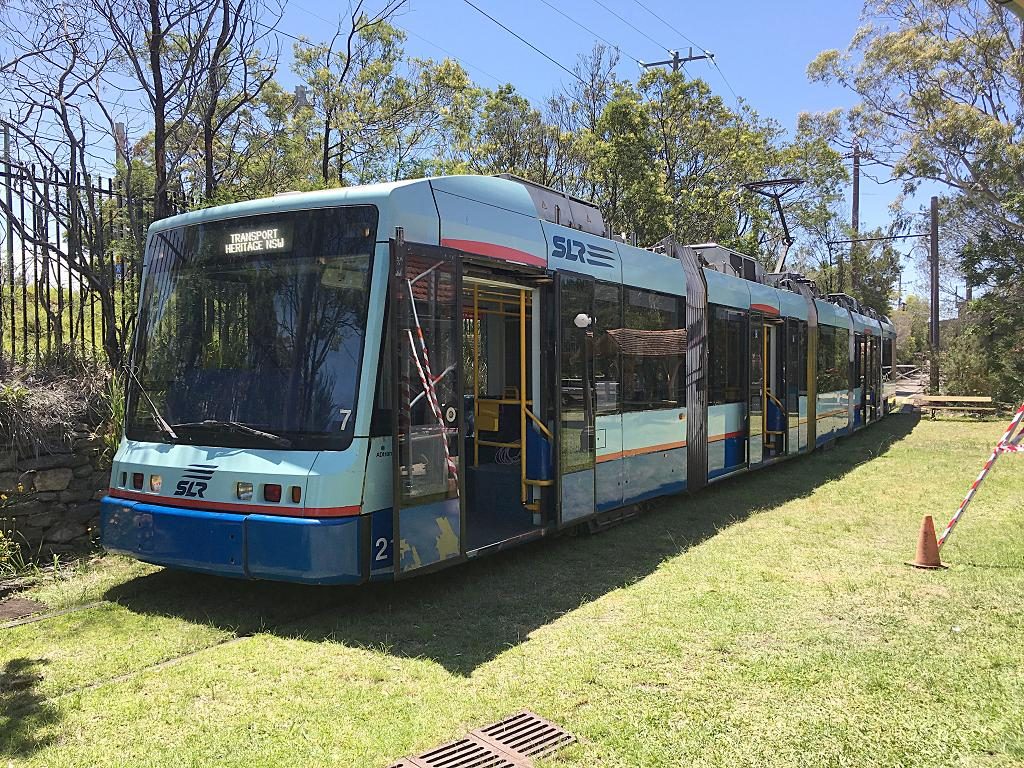Frequently asked questions
The Variotram prompts a lot of questions, particularly the technological leap between the Sydney R1 class tram and the Variotram, and the fact our museum tramway is built to ‘traditional’ tramway standards.
Current status
As of July 2020
The car can operate and all key systems work. All 4 traction converters operate giving full drive to all 8 driven wheels. Brakes function although they can be slow to release at first. The braking hydraulics have some issues that indicate we may need to bleed the system. However the brakes do function correctly. The braking system is ‘fail safe’ in that it is spring applied, hydraulic pressure released and despite the issues identified, the brakes release and apply properly.
Airconditioning set to vent only – compressors need an overhaul.
Several saloon light drivers have failed. The driver boards need replacing as they have ran hot and burned. We plan to make copies with small alterations to improve long term reliability.
ATP functionality has been disabled. The ‘train’ computer has been ‘tricked’ into thinking the ATP computer is alive and active, when in fact it has been disconnected. This prevents ATP failure emergency brake application or logging ‘ATP isolated’ errors when the ATP is cut out.
Wheel profile is not compatible with ‘traditional’ Sydney tramway points. Points must be crossed a low speed. Planning in progress to reprofile the wheels.
Museum overhead is not yet pantograph ready. Waiting on a major rail contractor to have a free slot for museum work.
The car is not certified to carry passengers and is restricted to operating as far as the picnic area only for testing and display.
Can 2107 operate on 600V?
The tram can operate (at reduced power) down to 500V. No modification was needed, that is the ‘way it came’. The main issue is the regenerative braking which would raise the overhead voltage to approximately 900 volts which
In June 2020 the new software was installed and braking tests conducted which verified that the voltage was now maxing out at 735v, while while still high, is acceptable. Further input from Bombardier is pending.
If the overhead line is detected as not being ‘receptive’ to regenerative braking the tram will automatically switch to on board dynamic braking resistors. These resistors are sized to enable the full emergency braking load to be absorbed.
The Mannheim (Germany) Variotrams could change from -750V supply to +600V supply and back without stopping. (Mannheim was -750V and Heidelberg was +600V, the trams through run between the two cities). This adaptive ability is a key part of the ‘Drive Control Unit’ software.
Can your substation power such a large tram?
The peak power draw for 2107 (including air-conditioning) is less than that for PCC 1014. However, tests at the end of the National Park line will be required to confirm calculations on voltage drop. 1014 will still move when the voltage drops below 500V. 2107 will not.
The traction converter pods on 2107 are rated at 166 amps input each. This the maximum rating – not a typical rating. The Auxiliary converter is rated at approximately 100 amps DC input, again this is a maximum not typical.
This gives approximately 440 amps maximum draw. A typical traditional bogie tram has it’s line breaker set to 300 amps.
The Variotrams had special wheels. How does this work on your track?
The ‘hybrid’ profile wheels are a combination of European/Melbourne street running flanges and a wheel back ‘step’ to allow running through railway style points raised check rails. Melbourne flanges are slightly too large for Sydney style track, but not majorly oversized. The step tends to ride up on the Sydney tramways style raised check rails. To ensure smooth trouble free operation the wheels need re-profiling before 2107 can be regularly used.
Are you going to fit trolley poles to 2107?
No. Such a modification would be out of character for the vehicle.
Are you going to modify the museum overhead for pantograph operation?
Yes. Waiting on a major rail systems contractor to find a time slot to do our job. Donations to offset the costs are welcome.
The overhead modifications will take too long for out limited volunteer workforce to undertake. The work will also allow other cars in the collection who have (or should have) pantograph power collectors to be operated.
Who owns 2107?
2107 is part of the State movable heritage collection and as such is owned by Railcorp and ‘managed’ by Transport Heritage NSW. The Sydney Tram Museum are the ‘custodians’ of the asset on their behalf.
Does the air-conditioning work ?
At this stage no, both air-conditioning pods are in need of overhaul and the compressors have been disabled to prevent them from being damaged. The pods currently circulate air only.
Indicative quotes from the manufacturer of the air conditioning are currently too expensive for the museum to progress with. There are other priorities.
Any donations of expertise in the area of HVAC systems would be gratefully received.
